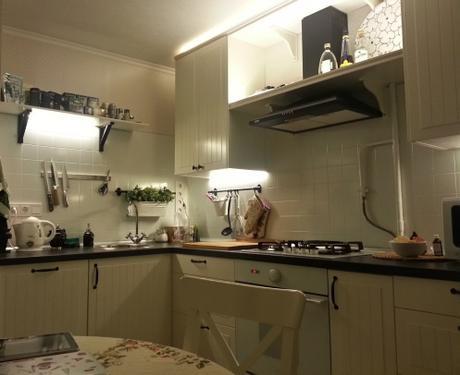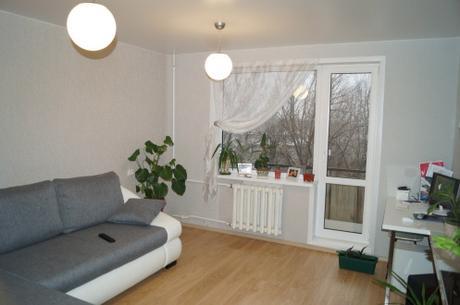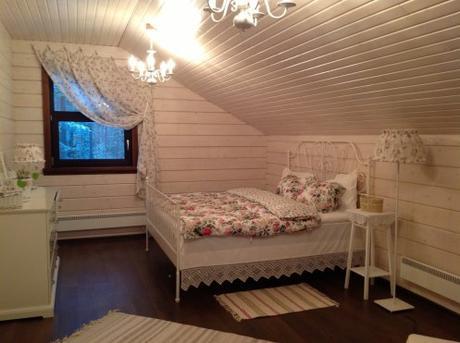IKEA (ИКЕА in Russian Cyrillic) was the Russian story that almost never happened. Still, the Swedish retail giant has transformed Russian kitchens, bathrooms and bedrooms in ways that the profit-wary communists of a few decades ago could have never imagined. In some ways, one might say that IKEA has finished what Richard Nixon started in the famous “Kitchen debate” with Nikita Khrushchev over 50 years ago!
The year was 1959. That July, USA Vice President Richard Nixon had traveled to Moscow to accompany the opening of the American National Exhibition, a USA-Russian exchange program held at Sokolniki Park. The Americans constructed an entire house filled with American appliances and home products, most of which were only a distant dream at the time for the typical Russian family. When Nixon treated Khrushchev to a tour, the two engaged in a spirited debate over the merits of capitalism versus communism.

Nearly every item in this kitchen, from cabinets, to fixtures, and to furniture and appliances is an IKEA product.
On 17 August 1998, IKEA’s Lennart Dahlgren arrived in Russia. Dahlgren, newly appointed as the future head of IKEA’s Russian division, was sent by IKEA founder Ingvar Kamprad to open the Russian market. The process to begin business in Russia took the company longer than expected, cost more than anticipated, and due to corrupt officials and bureaucracy, the retail giant came very close to abandoning their Russian stores altogether.
The city of Moscow offered locations for the first store, but it was soon clear that the cost of opening inside the city limits was far higher than ordinary real estate and construction expenses. Then-mayor Yuri Luzhkov had suggested several sites, but when the company expressed interest in another property along one of Moscow’s major avenues, Kutuzovsky Prospekt, company officials claim that the city mailed flyers that resembled IKEA letterhead to local residents. The flyers, an apparent forgery, stirred up opposition to the site.

From sleeper sofa, to lighting fixtures, to the desk and curtains, these are IKEA products.
IKEA eventually chose to open their first store in the Химки (Khimki) region, just outside city limits. That store faced unique obstacles and the opening was delayed after police raided the store just days before the scheduled grand opening. Officials claimed that a highway off ramp that had been constructed to handle the projected store traffic was in the wrong spot. The fact that officials had previously approved the ramp design, and inspectors had approved the construction process, seemed to have been forgotten.
Located in a busy shopping area along Leningrad Highway, the main road to Sheremetyevo (SVO) airport, it took a few months later, and several million dollars for a new government approved contractor to rework the highway ramp. However, with officials satisfied the project moved forward.
In June 2000, some forty-one years after the “”kitchen debate” between Nixon and Khrushchev, IKEA was ready to advertise the grand opening of their first Moscow store. But, there was another hitch: government officials at first banned the ads, saying that recent studies had discovered that consumers exhibit unstable moods when in underground floors, and that adverts promoting a store with an underground retail level might constitute a danger to public health. Foreign investors have long believed that local officials protect Russian businesses against competition by employing excessive regulations and operating restrictions.
Despite the challenges, the first IKEA opened to a crowd of excited shoppers. The line to enter the store was several hours long, traffic in the area was jammed, and by the close of business that day, thousands of shoppers had picked the store clean. While hard to fathom, official estimates put the opening day traffic at near 40,000 shoppers.
Even then, there were kinks to resolve. The first day almost bombed when shoppers thought that prices were written in US dollars. At that time the dollar was the most trusted currency following Russia’s recent default and currency devaluation. There was a big difference between $600 and 600 rubles and quickly store employees set about writing “rubles” alongside prices to put shoppers at ease. For the rest of 2000, the average floor traffic exceeded 100,000 shoppers per week.
Bureaucratic hurdles have sprung up often, and for the most part IKEA has held the line on refusing to pay bribes to local officials. The company did agree to a $30 million donation to a charity benefiting the elderly to gain permits to build a large distribution centre outside Moscow in 2003. There was also a scandal during the acquisition for property in St. Peterburg when a former IKEA CEO allegedly approved an under-the-table arrangement between a large Russian subcontractor and local officials. The CEO was fired. Although unverified, Dahlgren says that he had sought a meeting with President Putin and IKEA founder Kamprad, but dropped the request after being told that the price tag for such a meeting was north of $5 million.
IKEA promotes their Russian stores with the slogan Наша мечта исполнить вашу (Our dream is to make yours real!) Simplicity, quality, and economy in pricing are at the heart of IKEA’s retail operations, and in a country where retail is at two extremes (products can be very high-end for the wealthy, with cheap goods for everyone else), the average Russian consumer has embraced IKEA with a passion.

Many a rustic countryside dacha has been transformed by IKEA furnishings.
IKEA has invested heavily since the beginning in promoting their brand. Along with their associated property management company, MEGA stores, IKEA conducted a promotion in December 2014 to remind Russian consumers that giving is as important as receiving. Random shoppers were offered a gift, and then they were given the opportunity to give a gift to another person. To see the conversations in English, enable the subtitles on your screen, and watch:
Given the small size of many Soviet-era apartments, many living rooms serve as bedrooms by night with the sofa becoming an overnight sleeper. That concept is evolving as traditional beds are gaining acceptance with new apartment designs and remodeling projects. Last year, IKEA outfitted a Moscow movie theatre with beds, replacing the normal theatre seating for a night. In September 2014, the company invited couples to spend the night at an IKEA store to experience sleep on a traditional bed.
The advertising and promotion investments in Russia seem to be paying off, and today Russia is IKEA’s fourth most profitable market. There are 14 IKEA stores in Russia: three in the Moscow region, two in St. Petersburg, and more outlets in Kazan, Yekaterinburg, Samara, Ufa, Nizhny Novgorod, Novosibirsk,
">
">
">Rostov-on-Don, Krasnodar and Omsk.
Perhaps IKEA has not only transformed Russian homes, but hopefully has affected Russian officials with insight on honesty and integrity in business transactions. Despite all the challenges, IKEA loves Russia, and Russians love IKEA. But, don’t just take our word for it–this housewife is very happy with the results of her latest shopping adventure:
